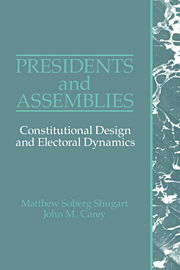Book contents
- Frontmatter
- Contents
- List of tables and figures
- Acknowledgments
- 1 Basic choices in democratic regime types
- 2 Defining regimes with elected presidents
- 3 Criticisms of presidentialism and responses
- 4 The premier-presidential and president-parliamentary experiences
- 5 The constitutional origins of chief executives
- 6 Constitutional limits on separate origin and survival
- 7 Legislative powers of presidents
- 8 Assessing the powers of the presidency
- 9 Electoral dynamics: efficiency and inefficiency
- 10 Electoral rules and the party system
- 11 Electoral cycles and the party system
- 12 Electoral cycles and compatibility between president and assembly
- 13 Conclusions
- Appendix A Electoral rules for one-seat districts and coalition-building incentives
- Appendix B Theoretical explanation for models predicting number of parties in presidential systems
- Bibliography
- Index
10 - Electoral rules and the party system
Published online by Cambridge University Press: 05 June 2012
- Frontmatter
- Contents
- List of tables and figures
- Acknowledgments
- 1 Basic choices in democratic regime types
- 2 Defining regimes with elected presidents
- 3 Criticisms of presidentialism and responses
- 4 The premier-presidential and president-parliamentary experiences
- 5 The constitutional origins of chief executives
- 6 Constitutional limits on separate origin and survival
- 7 Legislative powers of presidents
- 8 Assessing the powers of the presidency
- 9 Electoral dynamics: efficiency and inefficiency
- 10 Electoral rules and the party system
- 11 Electoral cycles and the party system
- 12 Electoral cycles and compatibility between president and assembly
- 13 Conclusions
- Appendix A Electoral rules for one-seat districts and coalition-building incentives
- Appendix B Theoretical explanation for models predicting number of parties in presidential systems
- Bibliography
- Index
Summary
In Chapter 9, we noted that Chile for many years combined a multiparty congress and, ordinarily, two-candidate competition for the presidency. In this chapter we generalize this observation with analysis of electoral rules. Students of electoral systems have long noted that plurality elections in oneseat districts tend to polarize electoral choices around two principal contestants, while systems of proportional representation are generally associated with multiparty systems. This chapter considers the implications of different electoral rules for party systems in presidential democracies. We have indicated already (in Chapter 2) that presidentialism does not by definition require that there be only a one-seat executive; however, the prevailing practice is to use districts of magnitude one (M=1) for the presidency. A district of M = 1 requires that the electoral system be some form of plurality or majority. Empirically plurality rule is more common, although majority runoff systems have been widely adopted among newer democracies since around 1980 in Latin America, and 1989 in Europe and Africa.
As indicated in Chapter 9, systems of proportional representation, in which the district magnitude must by definition be greater than one (M > 1), are typical for assemblies even in presidential and premier-presidential systems. Before presenting empirical data on the effects of these electoral systems, we should review the most widely discussed statement on this matter, known as “Duverger's law” or “Duverger's rule.”
- Type
- Chapter
- Information
- Presidents and AssembliesConstitutional Design and Electoral Dynamics, pp. 206 - 225Publisher: Cambridge University PressPrint publication year: 1992
- 1
- Cited by



